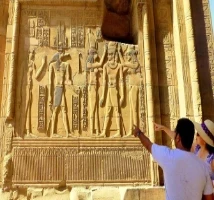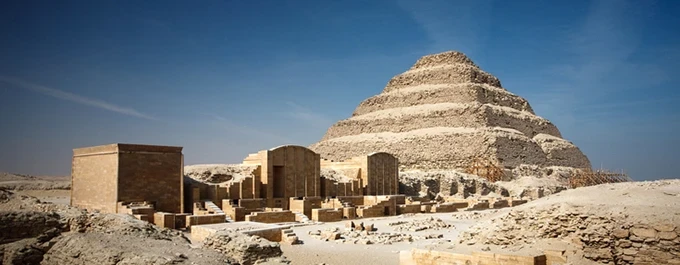The great Pharaohs of Ancient Egypt ruled the land for thousands of years and witnessed monumental feats in architecture, art, and culture. These kings and queens were regarded as divine, acting as mediators between the gods and the people. Ancient Egypt's history had its fair share of renowned Pharaohs: the great builder Ramses II, the young Tutankhamun, the mighty Cleopatra, and the visionary Akhenaten. Each of them created an indelible mark upon Egyptian civilization and thus set the mold for one of the oldest and most interesting cultures in the world. The history of Ancient Egypt covers over three thousand years, and since there were dozens of rulers, a whole lot of Pharaohs came into the picture. Here are some of the famous ones from different periods of Ancient Egypt, arranged according to their dynasties:
Early Dynastic Period (c. 3100–2686 BCE)
Narmer (Menes)
Narmer unified Upper and Lower Egypt into one kingdom and hence became the first pharaoh of the First Dynasty. Narmer is considered the founder of ancient Egypt's dynastic rule, and he is commonly associated with the Narmer Palette, which symbolizes the unification of the two lands. His reign would establish the pattern for Egypt's central state and its brilliant, vital culture.
Djoser
Djoser was the pharaoh in Egypt who ruled during the Third Dynasty, circa 2670 BCE. He is remembered for having ordered the construction of the Saqqara Step Pyramid, designed by his architect Imhotep. In this, the first pyramid ever built, Egyptian architecture evolved from simple mastaba-style tombs to the classic pyramid shape. Djoser's reign is also marked by the elaboration of Egypt's administrative and religious apparatus, through which the general features of the monarchy were delineated for many centuries ahead.
Old Kingdom (c. 2686–2181 BCE)
Sneferu
Sneferu was the pharaoh of Egypt best known for his works concerning pyramid construction. Major pyramids that he constructed include the Meidum Pyramid, the Bent Pyramid, and the Red Pyramid. This indicates major steps that were developed in architectural techniques. Sneferu developed the pyramid from the earlier, typical step pyramids into the classic, smooth-sided pyramid that became accepted in ancient Egypt. His rule is also characterized by economic progress and stability.
Khufu (Cheops)
Khufu was the pharaoh of Egypt best known as the commissioner of the Great Pyramid of Giza, one of the Seven Wonders of the Ancient World. The pyramid was his tomb and reflected the remarkable engineering ability of ancient Egypt; it remains one of the most highly recognizable structures in the annals of mankind. Khufu's reign is most commonly associated with monumental construction projects and the centralization of royal power, but little is known of his personality or rule beyond these grand achievements.
Khafre
Khafre was the pharaoh of Egypt who ordered the construction of the second-biggest pyramid at Giza and the Great Sphinx, believed to be a portrait of the pharaoh. The pyramid complex of Khafre, the son of Khufu, furthered the greatness of his father. Under him, the arts and architecture continued to be developed, with the Sphinx being the most iconic symbol of ancient Egypt.
Menkaure
Menkaure was the pharaoh of Egypt and is remembered for ordering the building of the smallest among three pyramids at Giza. The smaller size notwithstanding, his pyramid complex was an astonishing architectural work. Menkaure is renowned for his statues, among them the famous triad statue with his queen, Khamerernebty, which reflects the high level of artistic achievement during his reign. His reign is generally viewed as a continuation of the greatness of the earlier Fourth Dynasty pharaohs.
First Intermediate Period (c. 2181–2055 BCE)
Mentuhotep II
Mentuhotep II was the pharaoh of the Eleventh Dynasty of Egypt. and is considered the reunifier of Egypt following the First Intermediate Period. His successful military campaigns and strategic alliances brought the period of political fragmentation to a close and restored centralized rule. Mentuhotep II's reign inaugurated the Middle Kingdom, a period of stability, economic growth, and cultural flourishing. He is also famous for his monumental mortuary temple at Deir el-Bahari, which served as the model for later pharaonic tombs.
Middle Kingdom (c. 2055–1650 BCE)
Amenemhat I
Amenemhat I was the pharaoh of Egypt during the Twelfth Dynasty and is considered the founder of this dynasty following the reunification of Egypt. He had strengthened central authority, reorganized the administration, and proceeded with military campaigns in Nubia and the Sinai. Amenemhat I transferred his capital to Itjtawy near the Faiyum for the better control of both Upper and Lower Egypt. His reign signaled the beginning of the golden age for the Middle Kingdom, with economic prosperity, stability, and the growth of literature and art.
Senusret III
Senusret III was the ruler in Egypt through the Twelfth Dynasty, and is considered to be among the greatest rulers of the Middle Kingdom. Remembered for his military campaigns, Senusret III fortified the borders of Egypt, especially in Nubia, and brought more control over the Sinai Peninsula. Senusret III initiated many significant administrative reforms that contributed to the development of government and commerce. His reign is marked by a great flourishing of the arts: portraits of this pharaoh depict him with a more realistic, at times somber expression. His reign is considered a high point in Egypt's Middle Kingdom.
Second Intermediate Period (c. 1650–1550 BCE)
Hyksos Kings
The Hyksos were a group of Asiatic rulers who conquered Egypt during the Second Intermediate Period, including Salitis, Bnon, and Apophis. They founded the Fifteenth Dynasty and ruled from the Nile Delta, with their capital at Avaris. It is to them that many attribute the introduction of the horse-drawn chariot, the composite bow, and other military improvements to Egypt. Although they were foreigners, they gained many of the Egyptian customs and fitted into the Egyptian society. Their rule ended with the expulsion by native Theban pharaohs led by Seqenenre Tao and Kamose, which finally gave way to the establishment of the New Kingdom.
New Kingdom (c. 1550–1077 BCE)
Ahmose I
Ahmose I was an early New Kingdom pharaoh who is best known for driving the Hyksos rulers from Egypt, thus reunifying the country and founding the Eighteenth Dynasty. His military campaigns in the Nile Delta were important features that brought the Second Intermediate Period of foreign rule to an end. Ahmose I's reign heralded the beginning of the New Kingdom, which was to be an era of phenomenal prosperity, military expansion, and great cultural attainments. He initiated a number of building projects, such as rebuilding temples and monuments that had been damaged by the Hyksos
Hatshepsut
Hatshepsut, one of the most successful female pharaohs in Egyptian history, was the ruler during the Eighteenth Dynasty of Egypt. She initially took on an intermediary role as a regent for her stepson, Thutmose III, but she later declared herself as pharaoh, taking on male titles and iconography to secure her position. She is widely remembered for her great building projects, especially her mortuary temple at Deir el-Bahari, and for her advancement of trade networks, especially with Punt. Her rule ensured years of peace and prosperity for Egypt, and she is remembered as a strong leader, full of vision.
Thutmose III
known to many as the "Napoleon of Egypt," was the pharaoh of the Eighteenth Dynasty and one of the most important military leaders in the history of Egypt. Through a series of very successful campaigns in the Levant, Nubia, and Syria, he built Egypt's empire to the greatest territorial extent it had ever known. Thutmose III also executed grandiose building programs and made great contributions to Egypt's culture and religion. After the death of his stepmother, Hatshepsut, he fully assumed the throne, consolidated his power, and led Egypt into a period of unparalleled wealth and influence.
Amenhotep III
Amenhotep III was the pharaoh of Egypt during the Eighteenth Dynasty, and presided over that dynasty's most spectacular period of power and wealth. His reign saw extensive diplomacy, including marriage alliances with foreign rulers, and the flourishing of arts, architecture, and luxury. Amenhotep III constructed monumental buildings, among them his famous colossi at Thebes, and ordered extensive building of temples and palaces. His reign was free from war, but its niceness provided the formative stage for the great religious reforms of his son Akhenaten.
Akhenaten
Akhenaten was the ruler of Egypt in the Eighteenth Dynasty, and his primary claim to fame was the radical religious reforms that he forced on his people. Indeed, he introduced monotheism and concentrated worship on Aten-the sun disk-and moved the capital to a new city called Akhetaten-modern Amarna. Akhenaten's innovation in religious and political locus had disrupted Egypt's traditional polytheistic beliefs and significantly brought changes in art and culture. His reign was filled with changes that many considered to be nothing less than scandalous, and after he died, his successor Tutankhamun managed to reverse many of Akhenaten's changes.
Tutankhamun
more commonly known as King Tut, was the pharaoh of Egypt in the Eighteenth Dynasty. Having come into power at such a young age, he is mainly known for reinstating the traditional polytheistic ways after Akhenaten's introduction of monotheism. His reign was short and uneventful, while his tomb, discovered by Howard Carter in 1922, was an unprecedentedly rich source of artifacts, which has made him one of the best-known pharaohs. He died at around 18 years, which has become a subject of intrigue and speculation.
Seti I
Seti I was the pharaoh of Egypt of the Nineteenth Dynasty. He was mostly known as an aggressive warrior and a great contributor to the architecture of Egypt. Seti I campaigned in the Levant and Nubia, securing Egypt's borders and restoring its dominance in the region. His building projects were also massive, including his great tomb in the Valley of the Kings and the Great Hypostyle Hall at Karnak. His reign thus set the stage for his son Ramses II to lead Egypt into the zenith of it power and influence.
Ramesses II
he was one of the rulers of Egypt in the course of the Nineteenth Dynasty. he has also equally been one of the most popular and the most powerful of all the pharaohs of Egypt. He is most famous, however, for his conquests, particularly the Battle of Kadesh against the Hittites, and for the defense of the territory of Egypt.. Ramses II also engaged in a lot of building activities, such as the construction of grand temples at Abu Simbel and the Ramesseum. Indeed, during his 66-year reign, stability, prosperity, and flourishing Egyptian arts and culture became common for him to be considered one of the most iconic pharaohs in Egyptian history.
Ramesses III
was the pharaoh of Egypt during the Twentieth Dynasty. He is often regarded as the last great pharaoh of the New Kingdom. His rule is known for his defense of Egypt against the multiple invasions, among them that of the Sea Peoples, which threatened Egypt's western borders. Ramesses III also strengthened the economy of Egypt through trade exchanges and military conquests and embarked on an extensive building program, which included the expansion of his mortuary temple at Medinet Habu. In spite of his successes, his later years were embraced by internal strife along with a decline in royal power, which signaled the beginning of Egypt's Third Intermediate Period.
Third Intermediate Period (c. 1077–664 BCE)
Sheshonq I
was the ruling pharaoh of Egypt during the Twenty-Second Dynasty and is best known for his military campaigns in the Levant, especially his involvement in the biblical account of the invasion of Israel. He achieved his goal of expanding the reach of Egypt to the eastern Mediterranean and protecting its frontiers. Sheshonq also succeeded in consolidating political control in Egypt and strengthening the Libyan dynasty’s hold who governed during this era. His leadership represented the comeback of Egyptian domination over the region; however, there were systems and factors internal to the region that weakened the central power over time.
Tefnakhte
was the ruler of Late Third Intermediate Period Egypt and is considered one of the major rulers responsible for the political fragmentation of Egypt. He was the prince of Sais in the Delta and briefly declared himself pharaoh, establishing the Twenty-Fourth Dynasty.He tried to unify Tefnakhte under his power, the opposite competitors being in the form of the Libyan dynasty-this growing influence of the Kushite kings from the south. His reign was filled with domestic disputes and he failed to achieve lasting control over Egypt that ultimately made a way for the rise of the Twenty-Fifth Dynasty.
Late Period (c. 664–332 BCE)
Psamtik I
was the founder of the Twenty-Sixth Dynasty of Egypt and is known to have reunited Egypt after it had been fragmented for some time and had foreign rule. He gained power over other powerful factions, the Libyan rulers included, and the Cushites, with the aid of mercenaries, mainly Greek soldiers. Psamtik I regained Egypt's power, reasserted its control over the Delta of the Nile, and then started a new era with renewed trade relations with other nations. His reign inaugurated the Saite Dynasty, a time of stability, cultural revival, and military strength, which prepared the ground for the final flourishing of Egypt before its Persian conquest.
Nectanebo II
He was an Egyptian pharaoh who ruled during the Thirtieth Dynasty. His rule was largely a series of defensive actions against the Persian Empire, which had conquered great swathes of territory across the region. He is known to have been recognized by his military action, including resistance against Persian invasions, and for the large building projects at the temples of Karnak and Denderah. Nevertheless, he was finally overcome by the Persians, who occupied Egypt again, putting a complete stop to the native rule and marking the beginning of the Second Persian Period.
Ptolemaic Dynasty (c. 305–30 BCE)
Ptolemy I Soter
was a Macedonian general under Alexander the Great, founder of the Ptolemaic Dynasty in Egypt. Upon Alexander's death, Ptolemy grabbed Egypt for himself, established his rule as pharaoh, and successfully won the independence of the region against other Diadochi-the rival successors of Alexander. Ptolemy I is remembered for consolidating, strengthening the economy of Egypt, and encouraging a period of cultural flourishing. He founded the famous Library of Alexandria and made the city a center of learning and intellectual activity. His reign ushered in almost three centuries of Ptolemaic rule over Egypt.
Cleopatra VII
She was the last active ruler of the Ptolemaic Kingdom of Egypt. Famous for her intellect, political astuteness, and romantic alliances with Roman leaders Julius Caesar and Mark Antony, she played an important role in Egypt's complex relationship with the Roman Empire. At a time when the Roman Empire was growing, yet convulsed with internal strife, she strove for Egypt's independence. Her dramatic life and tragic death—after the defeat of Antony and her own suicide—pointed to the end of the Ptolemaic Dynasty and the incorporation of Egypt into the Roman Empire. Cleopatra is one of the most renowned andenigmatic figures in history.











-webp.webp)


